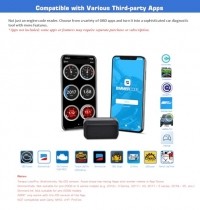Have you upgraded your Toyota Tundra with larger tires and noticed your speedometer and odometer are no longer accurate? It’s a common issue, and while professional recalibration services exist, they can be costly. Fortunately, there’s a surprisingly affordable and functional solution available right at your fingertips: using an Android Obd2 Odometer Correction Tool. This guide will walk you through a simple DIY method to get your readings back on track using a Bluetooth OBD2 module and an Android app.
The Cheap Solution: Bluetooth OBD2 Scanner and Android App
For those looking for a cost-effective approach, a Bluetooth OBD2 scanner paired with a compatible Android application is the answer. One popular and highly-rated option is the Veepeak OBDCheck BLE Bluetooth OBD II Scanner, readily available online.
This module, often priced around $30, works seamlessly with both Android and iOS devices. For Android users, apps like OBD Fusion offer robust functionality and positive user reviews. OBD Fusion, typically costing around $10, provides the necessary tools to not only read real-time vehicle parameters but also adjust settings for tire size correction, effectively acting as your android obd2 odometer correction tool.
 Close-up of the Veepeak OBDCheck BLE scanner plugged into a vehicle's OBD2 port, highlighting the ease of connection for accessing car data and performing odometer adjustments with an Android OBD2 app
Close-up of the Veepeak OBDCheck BLE scanner plugged into a vehicle's OBD2 port, highlighting the ease of connection for accessing car data and performing odometer adjustments with an Android OBD2 app
Step-by-Step Guide to Speedometer and Odometer Correction with Android OBD2
Using this setup on a Gen 3 Toyota Tundra is straightforward. The OBD Fusion app allows you to view various real-time parameters, including boost pressure, and crucially, correct your speed reading based on your larger tire size.
To adjust for larger tires within the app, navigate to the settings menu, then to “vehicle editor,” and finally scroll down to the “vehicle speed scale factor” table. This setting allows you to input a scale factor to compensate for the difference in tire circumference. For instance, if you’ve upgraded to 285/75R18 (approximately 35-inch) tires, starting with a scale factor of 1.15 or 1.16 is a good starting point. You’ll need to fine-tune this value by comparing your app’s speed reading with a GPS speedometer to achieve accurate results.
It’s important to note that this method corrects the speed and odometer readings within the app itself, not on your vehicle’s physical speedometer. However, this means your odometer will accumulate mileage more accurately based on your actual travel distance, which some owners see as a benefit.
Benefits of Using an Android OBD2 Odometer Correction Tool
Besides the primary function of odometer correction, this Android OBD2 setup offers several advantages:
- Real-time Monitoring: You can use your Android phone as a digital gauge cluster, displaying parameters like coolant temperature, oil temperature, battery voltage, and torque output.
- Customization: The OBD Fusion app is highly customizable, allowing you to tailor the displayed gauges to your preferences.
- Cost Savings: For around $35 total, this solution is significantly cheaper than dedicated speedometer calibrators or professional services.
- Portability: The OBD2 module is easily transferable between vehicles, making it a versatile diagnostic and correction tool.
Alternatives Considered: Banks iDash
While exploring solutions, the Banks iDash gauge was considered as an alternative. This is a more comprehensive product with integration capabilities with other Banks Performance products. However, for the specific need of speedometer and odometer correction on a Toyota Tundra without plans for a Banks tuner, the cost of the iDash (over $300) wasn’t justified. The simplicity and affordability of the Android OBD2 solution made it the more practical choice.
Conclusion: Accurate Readings on a Budget
For Toyota Tundra owners and potentially other vehicle owners who’ve upgraded their tires and need to correct their speedometer and odometer, an Android OBD2 odometer correction tool is a fantastic, budget-friendly option. By using a cheap Bluetooth OBD2 module and an app like OBD Fusion, you can easily achieve accurate speed and mileage readings, along with gaining a wealth of real-time vehicle data. This DIY approach provides a valuable and cost-effective solution for maintaining accuracy after tire modifications.